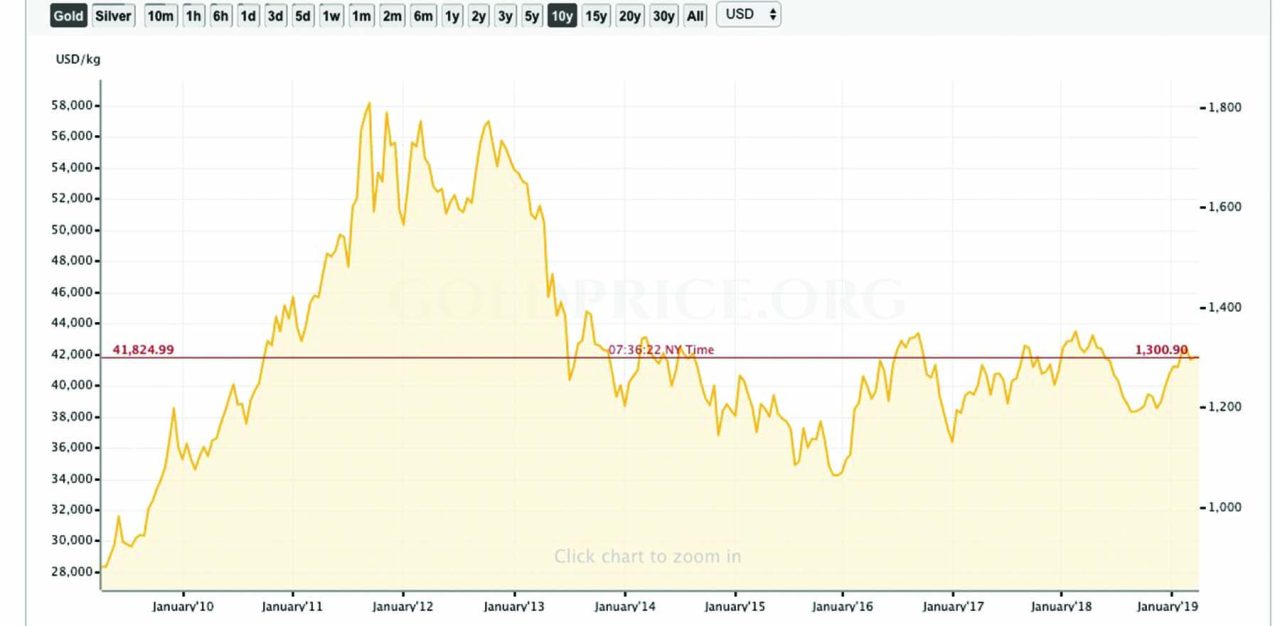By: SASE Singh; M.Sc. – Finance, ACCA
Something big is happening with the gold stock at the Bank of Guyana right now. Last year was a watershed in the size of the official gold stock, as it fell to its lowest level since 2001, and the Bank of Guyana continues to shed its stock of gold clearly for political reasons rather than economically sensible reasons. Who sells a product when the price is low? (See graph below with price).

The value of the stock of gold at the Bank of Guyana in March 2019 was G$1,934 million, compared to the PPP days in 2014 when the value of the gold at the Central Bank was G$25,014 million. (See graph in blue below).

This is nothing to celebrate when one watches the price of gold from 2014 to March 2019. From the graph in yellow above, one can see that the price of gold has not climbed above US$1,300 an ounce for most of this period, yet the Central Bank chooses to sell most of its gold lock, stock, and barrel since 2014. The only conclusion one can find for such a fire sale is that the US dollars were needed to prop up the rapidly dwindling foreign reserves. If one were to reflect on the implosion in sugar exports since 2014, one can understand why this gold was sold at great loss to Guyana.
It is an irrefutable fact that with the major gold investors, much of the foreign currency generated by those companies leaves Guyana and never returns, unlike the rice, sugar, bauxite, timber, seafoods, and rum exports. The Central Bank depends on these foreign currency flows. The fact shows that, in 2013, sugar exports brought in US$114.2 million to the Central Bank. In 2018, the sugar sector brought in only US$27.1 million. That is a reduction in foreign currency inflows from the sugar sector of some 86 per cent, or US$87.1 million. That is a hole needed to be filled, thus the gold sales.
Similarly, there has been a reduction in the foreign currency earnings from the rice sector between 2013 and 2018 of some US$53.7 million (22 per cent). Foreign currency earnings from bauxite, timber, pharmaceuticals, garment, and molasses all declined.
In 2013, foreign currency earning from the garment industry was US$6.8 million. At the end of 2018, it was US$0.3 million. This represents a total collapse in garment exports. While countries like Haiti and El Salvador (no better than Guyana), are expanding their garment industry, here in Guyana we have a clueless bunch in Government and at places like GO-INVEST who refuse to see the opportunities that this industry can create for the people. In 2013, the World Bank in a report wrote off the Haiti garment industry. Today Haiti exports some US$833 million in garments to the world. Same story with El Salvador.
What have Team Granger done since they came to power? Destroy! Destroy! Destroy! These people have the reverse Midas touch. Everything they touch is destroyed. They did it to the sugar industry. They did it to the forestry sector. They did it to the garment industry.
Their hallmark remains massive acts of incompetence and policy paralysis, embellished with their runaway acts of corruption. Take, for example, the national airport. They said they spent US$35 million on sand, when the sand pits were less than 5 miles away. US$35 million in sand my foot!
In the final analysis, similar to what happens in a horse race when the thoroughbred moves east, the “kangala” moves west. Reading a CNBC Report from January 2019, it stated that in 2018, around the world, Central Banks bought the most gold by volume to add to their stock since 1967. Meanwhile, the “kangalas” in Guyana who are making the decisions continue to sell our stock of gold at these low prices. When will the dotishness end?

